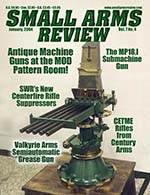by Timothy Kast
How can you improve a gun that is already the favorite sidearm of the military and law enforcement? You can upgrade the sights to tritium night sights or a laser system. Fit different grips or maybe use a custom guide rod. All of those things affect the overall accuracy, but how do you truly make a good gun better?
Bar-Sto Precision Machine has been around for over thirty years and in that time-span they have been making barrels for a substantial number of classic handguns. The M1911 Government Model, the Browning High-Power, Glocks and the SIG P226 have all been transformed by the addition of Bar-Sto barrels. Distinguished by their CNC-engraved name on the side of the chamber, Bar-Sto barrels have been used exclusively by the US Marine Corps Marksman Unit since 1977. They have also been in nearly every winner’s gun at the Masters, the Steel Challenge, the U.S.P.S.A. Nationals, and the Camp Perry Bullseye Nationals.
The caliber 9x19mm Parabellum SIG P226 carries an impressive list of credentials as well. US Navy SEALs shot 30,000 rounds each through five pistols in the JSSOC trials before it became their standard duty pistol. Acceptance was approved shortly afterward and the Teams received their first guns the 20th of January 1989. Several Federal agencies have also adopted the P226 due to its accuracy and reliability. The SIG is comparatively an expensive gun, but administrators are apparently willing to pay more to equip their personnel with the P226. SIG pays exceptional attention to the perfection of their barrels, reaming out each individual barrel if they display any tendencies to ammunition sensitivity. Fitting a Bar-Sto barrel to a SIG P226 would be a true test of Bar-Sto’s performance capabilities.
Bar-Sto manufactures drop-in barrels and these work well and produce 13/4- to 2-inch groups using match-grade ammunition at 25 yards. However, I wanted to evaluate the “fitted-barrel” option that Bar-Sto offers as they claim 11/2-inch groups or better for this option.
On the range the first test I performed was a corroded ammo assessment. I chose approximately one hundred rounds of assorted aged and corroded ammunition. This would be apart from the regular ammunition used in the test. The Bar-Sto barrel digested all but two rounds.
When I had received the SIG back from Bar-Sto, I had noticed the action was very tight and crisp upon retracting the slide. This snugness began to wear in gradually the more I shot it. Bar-Sto fits these very barrels in just such a fashion so as to provide the utmost in accuracy for their customers. Bar-Sto barrels are machined from solid 416 stainless steel bar stock that has been previously heat treated to 180,000 pounds tensile strength. All of Bar-Sto barrels are machined, bored, and rifled on site. The rate of twist is specified at right-hand with one turn in 16 inches.
The corresponding testing was done using mostly military-grade ball ammo and jacketed hollow point, as well as frangible. A wide range of these types of ammunition was evaluated.
The ammunition used in SAR’s test and evaluation was as follows:
- Famae 9mm Parabellum (Chilean)
- China Sports 124-grain FMJ 9mm Parabellum (Chinese)
- Olin Corp. 9mm Ball NATO M882 (US military-issue)
- Winchester 9mm Luger 115-grain FMJ (commercial)
- Denel PMP 9mm Luger 115-grain FMJ (South African)
- International Cartridge Corp. (Frangible) 9mm Luger 100-grain FP
- Geco 124 grain full metal case (FMJ) 9mm Luger (German)
- Impact 9mm 147-grain JHP Subsonic (Specialty)
- Lazer Ammo 9mm Luger 115-grain FMJ (Match)
The ambient temperature was 36( F with a moderate 12-mile per hour wind, and no visible precipitation. The distance was 25 yards.
Military ball ammo presented no problem in cycling, sliding effortlessly up the polished ramp into the chamber, as did the frangible cartridges. The jacketed hollow point ammunition likewise functioned perfectly.
The barrel at this point was becoming more seated as the testing progressed - the slide, barrel, and frame working together in harmony throughout each magazine load. This part of the evaluation was the most enlightening; making one of the finest duty guns ever function even more flawlessly. Saving the best ammunition for last, I proceeded to shoot consistent 11/4-inch groups. Accuracy is a legitimate challenge for the armed professional seeking to perfect his or her duty sidearm.
The SIG P226 has been adopted by more agencies than any other pistol since the 1911A1 or the Browning High-Power. Those individuals wishing to hone the accuracy of this fine sidearm even closer now have an option. Whether you choose a Bar-Sto drop-in or opt for the hand-fitted barrel, you will find you have taken your piece to a higher level of excellence by doing so.
Bar-Sto Precision Machine
Dept. SAR
P.O. Box 1838
73377 Sullivan Road
Twentynine Palms,
California 92277
Phone: 760-367-2747
Fax: 760-367-2407
Email: barsto@eee.org
www.barsto.com
This article first appeared in Small Arms Review V7N4 (January 2004) |
| SUBSCRIBER COMMENT AREA |
Comments have not been generated for this article.



